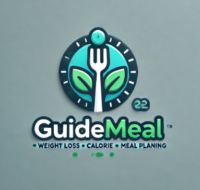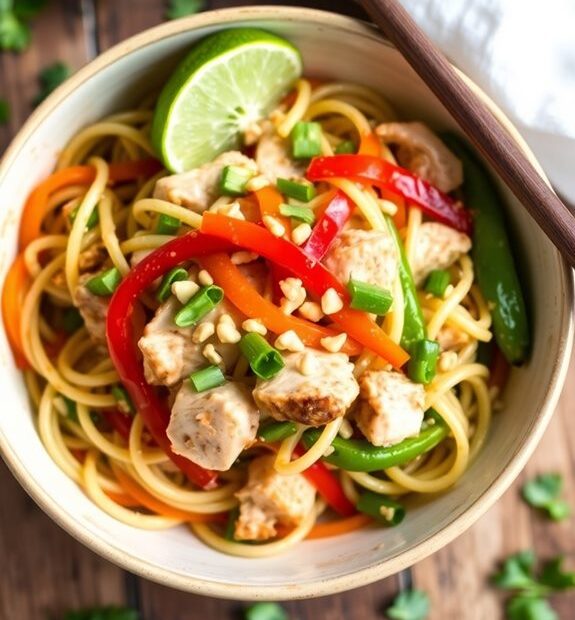You can whip up a tasty Low-Carb Pad Thai with zucchini noodles that's sure to satisfy! 🌱 Start by spiralizing two zucchinis or using shirataki noodles. You'll sauté minced garlic in coconut oil, add your choice of protein, and scramble some eggs for a cozy texture. Mix everything with tamarind, lime juice, and other seasonings. Don't forget the fresh veggies! 🍤🥬 It's quick, healthy, and customizable to fit your taste. Who doesn't love a good meal that's also nutritious? If you want to impress your friends and family with this dish, just wait till you discover more tips!
Key Takeaways
- Low-Carb Pad Thai replaces traditional rice noodles with spiralized zucchini or shirataki noodles for a healthier option.
- Key ingredients include coconut oil, protein of choice, tamarind paste, and fish sauce for authentic flavors.
- The dish is quick to prepare, making it accessible for busy individuals seeking healthy meals.
- Customize your Pad Thai with shrimp, chicken, tofu, and adjust spice levels to suit your taste.
- Garnish with fresh cilantro, crushed peanuts, and lime wedges to enhance the dish's flavor and presentation.
History
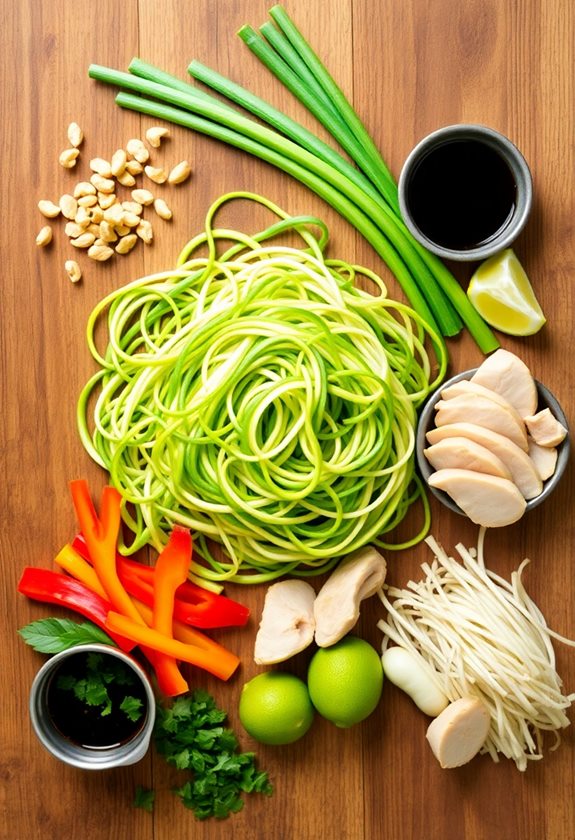
The history of Pad Thai is as rich and complex as its flavors. Have you ever wondered how this beloved dish came to be? Pad Thai actually has its roots in Thailand, dating back to the 1930s. During this time, the Thai government wanted to promote national identity and encourage people to eat a more unified dish. They introduced Pad Thai as a simple, affordable meal that everyone could enjoy. This dish, much like the diverse recipes found in meal prep for weight loss, quickly became a staple in many households.
Originally, it was a street food, made with rice noodles, vegetables, and proteins like shrimp or chicken. The dish quickly became popular, and you'd find it everywhere from bustling markets to home kitchens. Isn't it fascinating how food can unite a culture?
When you savor Pad Thai today, you're tasting a blend of influences from Chinese stir-fry and Thai spices. It's a perfect example of how food evolves over time, adapting to local tastes and ingredients. Plus, it reflects the love and creativity of Thai chefs who keep the tradition alive.
Recipe
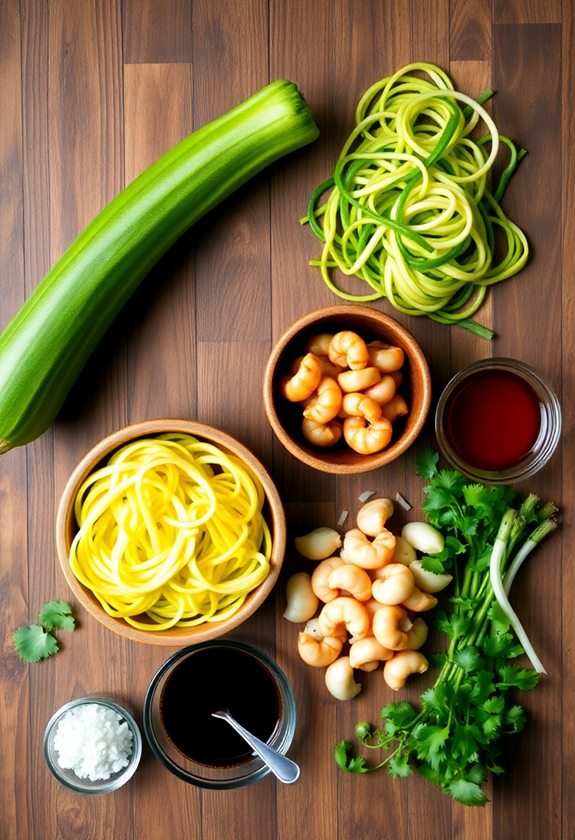
Low-Carb Pad Thai is a delicious and healthy twist on the traditional Thai noodle dish, perfect for those looking to reduce their carbohydrate intake without sacrificing flavor. This recipe substitutes traditional rice noodles with spiralized zucchini or shirataki noodles, making it a light and satisfying option. The vibrant flavors of tamarind, fish sauce, and fresh vegetables combine beautifully, providing a delightful meal that is both nutritious and filling. For those following a ketogenic diet, incorporating MCT oil powders can enhance energy levels and support overall health while preparing this dish.
This dish is not only quick to prepare but also customizable to suit your preferences. Feel free to add your choice of protein, such as shrimp, chicken, or tofu, and top it off with fresh herbs and crushed peanuts for added texture. With a few simple ingredients and a bit of creativity, you can whip up a low-carb Pad Thai that will impress your family and friends.
Ingredients:
- 2 medium zucchinis (spiralized) or 8 oz shirataki noodles
- 1 tablespoon coconut oil
- 1 cup cooked shrimp, chicken, or tofu
- 2 cloves garlic (minced)
- 2 eggs (lightly beaten)
- 2 tablespoons fish sauce
- 1 tablespoon tamarind paste
- 1 tablespoon lime juice
- 1 tablespoon erythritol or your preferred low-carb sweetener
- 1 cup bean sprouts
- 1 green onion (sliced)
- Fresh cilantro (for garnish)
- Crushed peanuts (for garnish)
- Lime wedges (for serving)
In a large skillet or wok, heat the coconut oil over medium heat. Add the minced garlic and sauté for about 30 seconds until fragrant. If using shrimp, chicken, or tofu, add it to the pan and cook until heated through. Push the protein mixture to one side of the pan, pour the beaten eggs into the other side, and scramble until fully cooked. Once the eggs are set, mix everything together and add the spiralized zucchini or shirataki noodles, fish sauce, tamarind paste, lime juice, and erythritol. Toss everything together until well combined and heated through. Finally, stir in the bean sprouts and green onions, cooking for an additional minute before removing from heat.
When preparing Low-Carb Pad Thai, keep in mind that the texture of zucchini noodles can be quite different from traditional noodles. To avoid a watery dish, be sure not to overcook the zucchini; they should be added towards the end of the cooking process. Additionally, feel free to adjust the seasoning to your taste, adding more fish sauce or lime juice if desired. For a more authentic flavor, consider incorporating crushed red pepper flakes for some heat, and always remember to garnish generously with fresh herbs and peanuts for the best presentation and taste.
Final Thoughts
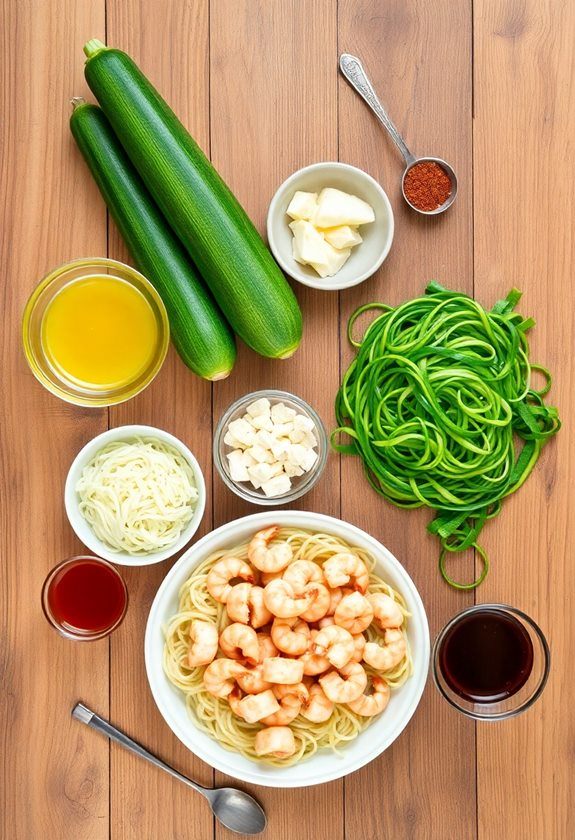
Creating a Low-Carb Pad Thai can be a rewarding experience that showcases your culinary skills while keeping your meals healthy. You'll find that using zucchini noodles instead of traditional rice noodles not only cuts carbs but also adds a fresh twist to this classic dish. In addition, preparing your meals in advance can help maintain a balanced diet that supports your active lifestyle, making it easier to stay on track with your weight loss goals. Have you ever thought about how simple swaps can make such a big difference? Meal prep enhances effectiveness of an active lifestyle.
As you experiment with flavors, don't hesitate to adjust the ingredients to fit your taste. Maybe you love a little extra spice or prefer a sweeter sauce? The beauty of cooking is that you can customize it just for you. Remember, it's all about enjoying the process and the delicious results!
When you sit down to enjoy your Low-Carb Pad Thai, take a moment to appreciate what you've created. It's not just a meal; it's a celebration of healthy choices and creativity. 🎉 So, why not invite friends or family to share in the experience? Cooking together can be a great way to bond and inspire others to try healthier meals too.
In the end, you'll realize that healthy eating doesn't have to be boring. Keep exploring, stay curious, and enjoy every bite!
